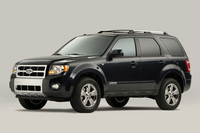2008 Ford Escape and 2008 Mercury Mariner Hybrid Reviews
THE AUTO PAGE
by
JOHN HEILIG
SPECIFICATIONS
Model: Ford Escape and Mercury Mariner Hybrid
Engine: 3.0-liter V6 (E)/2.3-liter Atkinson cycle I4 (M)
Horsepower/Torque: 200 hp/193 lb.-ft.(E)/133 hp/torque NA
Transmission: 4-speet automatic (E)/ECVT (M)
Wheelbase: 103.1
Length x Width x Height: 174.7/71.1/68.0 in.
Tires: P225/65R17 (E)/P235/70R16 (M)
Cargo volume: 66.2 cu. ft.
Economy: 17 mpg city/22 mpg highway/ 22.1 mpg test (E)/34 mpg
city/30 mpg
highway29.3 mpg test (M)
Fuel capacity: 16.5 gal.
Price: $$30,910 (E)/$31,000 (M)
The Bottom Line: Hybrids often carry a price bogey that makes them less-than-attractive. The Mercury Mariner Hybrid, however, is almost exactly the same price as the less expensive Ford Escape, yet offers attractive fuel economy in an identical package (with trim differences).
Because of the logistics of scheduling, side-by-side comparisons are nearly impossible to arrange and almost as difficult to perform. However, within a space of two weeks, we had an opportunity to test two Ford small sport utilities, one with a conventional V6 engine and the other with hybrid technology.
Now a long Interstate teat is one way to test s small SUV. But a hybrid is a different animal. These vehicles usually have higher city economy than highway. Our situation demanded long Interstate runs with both vehicles, though.
We drove the Mercury Mariner hybrid first. We headed to Virginia on a 700-mile round trip. I was impressed first with the practical size of the Mariner. It's classified as a small sport utility, yet there was an enormous amount of carrying capacity, 66.2 cubic feet with the seats folded. The rear seats folded easily to provide a flat floor. That was more than enough for our purposes.
The combination of the Atkinson cycle four-cylinder with electric backup offered enough power for all the driving situations we encountered. We had enough speed to keep at or above the posted speed limits, and still could accelerate away from any 18-wheelers that threatened our safety.
The front seats were comfortable. They felt hard at first, but either we became accustomed to them or they softened, by the end of the run we were happy with them.
Handling was very good, although I made some dumb moves along the way that could have gotten us in trouble. I felt that the Mariner was adversely affected by strong cross winds, which we encountered in several spots. It wasn't a serious problem, but we did feel the wind.
In the Escape, we drove over some semi-twisty back roads and dirt. There was surprisingly little lean on corners, although we didn't try hard corners. With both vehicles' aspect ratio, we might have expected more lean.
My only complaint about the Mariner also was for the Escape. I liked the instrument panel, but the speedometer and tachometer had too many hash marks. They didn't help provide more information and just made the gauges difficult.
The neatest feature was backing into my driveway. The gasoline engine shuts off and, at speeds below 25 mpg, stays off, so I backed an electric car (sort of) into the driveway.
Our test in the identical Ford Escape took us on an even longer journey, 1300 miles. Again, we spent most of our time on Interstates. With the 200 hp 3.0-liter V6 we had, again, enough power to stay out of trouble or get into trouble, whatever we chose. We chose stay out. Even with the vehicle fully loaded, we found that there was plenty of power available.
Fuel economy on our trip actually exceeded the EPA estimates at 22.1 mpg. This was seven mpg lower than with the hybrid, though. So in this unscientific almost side-by-side test, the hybrid came out the winner, with no extra charge for the newer technology.
In both vehicles, the ride was comfortable and I felt all the controls were in the right places. All too often, interior designers, in their attempt to be "cute,", place controls at inconvenient locations that can make the drive dangerous as you search for them.
Both vehicles had excellent audio systems with Sirius satellite radio. Both had navigation systems that we didn't really need, since we were headed for familiar locations.
The base price of the Mariner was slightly higher than the Escape ($25,765 vs. $25,330). The Mariner added a Premium Package ($3,395) that added power heated mirrors, heated front seats, the navigation system, roof rack, and leather trim; plus $995 for the Hybrid Moon & Tune Package with a power moonroof and Sirius radio; and $180 for a 110v electrical outlet.
The Escape added a Limited Luxury Package ($795 that had the heated mirrors and seats, a Rear Cargo Convenience Package ($295), Chrome Appearance Package ($195), Class II trailer towing ($345), navigation system ($2,395), 17-inch chrome clad wheels ($695), and satellite radio ($195). Both vehicles also had a $665 destination and delivery charge.
In nearly identical vehicles, I was surprised to see that the highway mileage of the hybrid was so much better than the gasoline engine. Around town, the economy should be even better. So for those who are iffy about a hybrid, here's an example of how much you can save.
If you're still committed to gasoline engines, the Escape (and standard Mariner as well) are both excellent vehicles that will do almost anything you ask of them. We've driven the Escape over tough mountain trails and we're sure the Mariner can handle them as well.
© 2008 The Auto Page Syndicate




